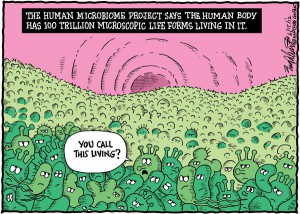Mapping the Human Genome Leads Where?
There have been exciting findings since the mapping of the human genome. For example, mitochondrial DNA and Y-chromosome DNA have been used to determine where humans originated and how we populated the earth. The research has found that your close friends are as genetically similar as if they shared a great- great- great-grandparent with you. And this research has investigated the microorganisms that are part of who we are as humans.
Only 1 in 10 Cells in the Body are Human
The human body contains about 100 trillions cells but that doesn’t mean they are all human cells. In fact only one in ten cells are human, the rest are the bacteria, viruses and other microorganisms that live symbiotically with us.
Symbiosis
 This symbiotic relationship is critical for survival of both the microbes and humans. The microbes have been found to help us digest…extracting important vitamins and nutrients. They are involved in helping our immune system fight disease. They are what is called the human microbiome, living on and in our bodies.
This symbiotic relationship is critical for survival of both the microbes and humans. The microbes have been found to help us digest…extracting important vitamins and nutrients. They are involved in helping our immune system fight disease. They are what is called the human microbiome, living on and in our bodies.
New research is shedding light on the impact of these microorganisms on our health. Specifically, researchers are asking this question: could an imbalance in a person’s microbiome lead to cancer?
Breast Cancer and the Human Microbiome
One study looked at breast cancer. In the majority of cases (the figure may be as high as 70%) the reason someone gets breast cancer is unknown. Could the microbiome of breast cancer tissue be different from normal breast tissue?
To find out, researchers obtained breast tumor tissue and normal breast tissue from 20 patients with estrogen receptor positive breast  cancer. They compared the microorganism populations in the different tissues.
cancer. They compared the microorganism populations in the different tissues.
The cancerous tissue had fewer S. yanoikuyae bacteria than the normal tissue. Previous research indicates that this type of bacteria may be important in human immune response, stimulating a type of T cell that controls cancer.
Another finding of this study is that the tissue of patients with Stage 3 breast cancer had the lowest amount of this type of bacteria in it.
We’re Left With Questions to Answer
Previous research has looked at microorganisms like viruses as causes of breast cancer. Yet it may be that things are much more complicated than this. Is it possible that the composition and amount of microorganisms in the human microbiome encourages disease development or maintains health? Only further research can shed light on this brave new world.






